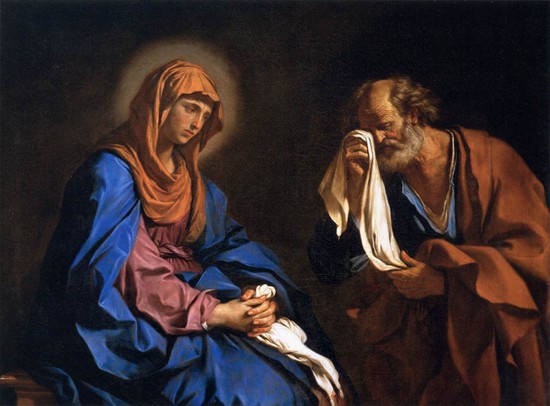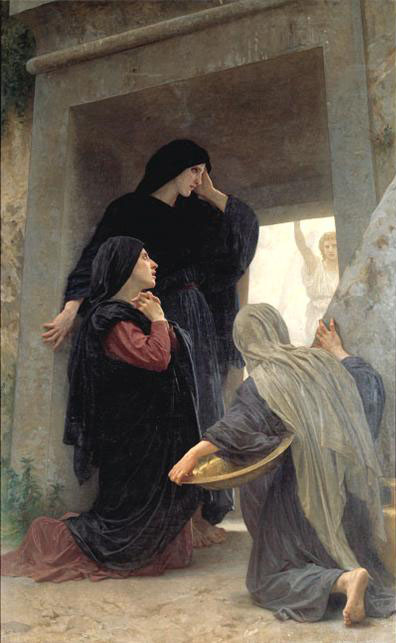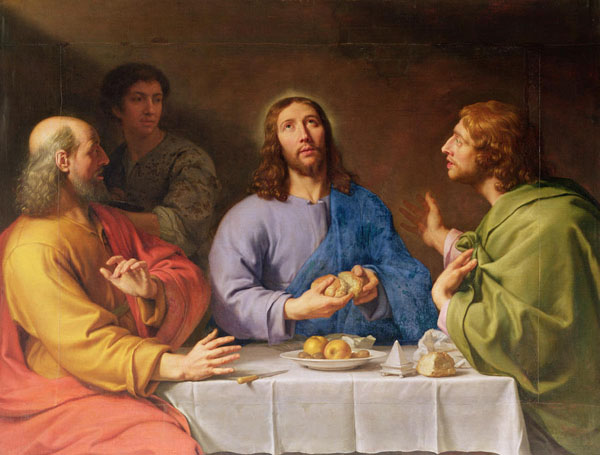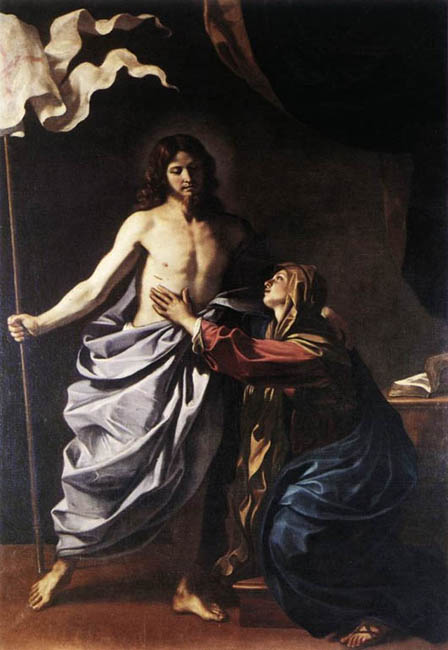
James Spencer Northcote was a convert to Catholicism, having been a married Anglican minister. At the death of his wife, also a convert, he entered the Catholic priesthood and eventually became president of St. Mary’s College at Oscott. Between the years 1856 and 1860 he gave a series of lectures to refute the Protestant claim that, according to the Bible, the Blessed Virgin Mary is nothing but an ordinary woman. They were later published, and furnish some of the best rebuttals in print against those who attack Catholic devotion to our Beloved Mother Mary. We present them in a slightly condensed form.

Our Lady consoles St. Peter on Holy Saturday.
Jesus rising early the first day of the week, appeared first to Mary Magdalene. (Mark 16: 9. Author's footnote—Anyone reading the 16th chapter of St. Mark attentively cannot fail to see that the word "first" in verse 9 is spoken, not absolutely, but relatively to the disciples and others mentioned in the preceding verses. The Evangelist had recorded the visit of several holy women to the tomb, and their mission to St. Peter and the other disciples. Then he adds verse 9, which tells us that before appearing to the Apostles, Jesus appeared "first" to St. Mary Magdalene.)
Nothing seemingly can be more precise and positive than this statement of the Evangelist, that Our Lord vouchsafed the first manifestation of Himself after His Resurrection to "her who had been a sinner;" and we would search the Gospels in vain for a single word by which to raise a question upon this point. Nevertheless, there is a feeling most deeply impressed on every Catholic heart, that the first appearance of our Risen Lord must needs have been vouchsafed to His Blessed Mother, and that such appearances must have been repeated again and again so long as He remained upon earth. This feeling is founded both upon the goodness and justice of God: His justice, because She was specially privileged to share in the Passion of Her Divine Son, and therefore must have shared also, in some eminent degree, in the joys and glories of His Resurrection; His goodness, because His kind and tender Heart must have yearned to console His Mother who had drunk so deeply of the chalice of bitterness at the foot of the Cross; and the only obvious means whereby this could be effected, is presumed to be the prerogative of the earliest and most frequent enjoyment of Christ's visible presence upon earth.
Accordingly, both devotional writers and commentators on Holy Scripture have not hesitated to say that Christ did not appear first to Mary Magdalene, but to Mary the Blessed Virgin; and they explain the silence of the Evangelists as to this appearance to His Mother, by saying that the Holy Ghost only cared to put on record those witnesses whose evidence could be appealed to as inspiring faith into unwilling and unbelieving minds; that Mary's near relationship to Jesus might have thrown discredit on Her testimony; that, as She neither doubted Herself a single moment about the fact of Her Son’s Resurrection, nor was She one of those preordained to preach it to the world, all mention of Her in this part of the inspired narrative was unnecessary.
 But that He really did vouchsafe His first appearance to Mary they consider certain. They quote the Easter Hymn of the Church, in which we call upon Her to rejoice because He Whom She has borne has risen as He said, and they ask how is it possible to conceive that a loving and dutiful Son should have withheld, even for a single hour after it was within His power to grant it, so great a joy and consolation from so faithful a Mother. A sword of sharpest sorrow had pierced Her soul in the Passion; and now that the fruit of that Passion was to be gathered, a torrent of joy suddenly inundates Her soul with gladness, and that deep wound is healed and filled with over-flowing sweetness, at the sight of Her risen and triumphant Son. But She kept it in Her own Heart, as She had done all things else from the beginning, and there was no need that She should reveal it. If the words of the other holy women, who had been only the faithful companions of Jesus, "seemed to the Apostles to be idle tales, and they did not believe them" (Luke 24: 11), how much less credit might they have given to the Mother's tale? Finally, if the silence of the Evangelists is to be insisted upon as excluding whatever they have not recorded, it would follow that Jesus never showed Himself at all to His Mother after His Resurrection, which is quite inconceivable.
But that He really did vouchsafe His first appearance to Mary they consider certain. They quote the Easter Hymn of the Church, in which we call upon Her to rejoice because He Whom She has borne has risen as He said, and they ask how is it possible to conceive that a loving and dutiful Son should have withheld, even for a single hour after it was within His power to grant it, so great a joy and consolation from so faithful a Mother. A sword of sharpest sorrow had pierced Her soul in the Passion; and now that the fruit of that Passion was to be gathered, a torrent of joy suddenly inundates Her soul with gladness, and that deep wound is healed and filled with over-flowing sweetness, at the sight of Her risen and triumphant Son. But She kept it in Her own Heart, as She had done all things else from the beginning, and there was no need that She should reveal it. If the words of the other holy women, who had been only the faithful companions of Jesus, "seemed to the Apostles to be idle tales, and they did not believe them" (Luke 24: 11), how much less credit might they have given to the Mother's tale? Finally, if the silence of the Evangelists is to be insisted upon as excluding whatever they have not recorded, it would follow that Jesus never showed Himself at all to His Mother after His Resurrection, which is quite inconceivable.
This is not the time or place for considering the weight of these arguments. I am only concerned to acknowledge and account for the fact that Our Lady's Name nowhere appears in the sacred records between that terrible scene of blood and darkness on Mount Calvary, and that other scene in the upper-room in Jerusalem, when "there came a sound from Heaven as of a mighty wind, and there appeared parted tongues as it were of fire;" between Good Friday and Pentecost Sunday. For if we consider the circumstances of the case, and the accuracy with which the most minute details of Christ's several appearances during the forty days between the Resurrection and Ascension have been recorded, we shall find it impossible to believe that this omission or silence has been without design; and since I am precluded by the very conditions of these Lectures from adding any facts from Our Lady's life beyond those which are written in the Gospel, I am at least bound to show you that this silence is in no way derogatory to the dignity which Catholic theology attributes to Her.
I think however that we may venture to say much more than this; I shall boldly assert that it is in the highest degree honorable and glorious to Her sanctity; and the proof of this assertion is simple. Not a single person is recorded to have had any share in the appearances of our Risen Savior, upon whom the Sacred Narrative has not set some mark of blame with reference to them; either for error or for ignorance, for weakness of faith or for positive incredulity; and it would seem that the sight of Jesus which was vouchsafed to them, was intended as a distinct remedy for the evils under which they labored.
Let us go through the several narratives of these appearances in their order, and we shall see the truth and the importance of this remark still more clearly. Thus, the first witnesses of the Resurrection were the holy women, who, with our Blessed Lady, were near the Cross at the crucifixion. They are mentioned by name on both occasions; only on the latter occasion, Our Lady no longer appears among them. They come to the sepulcher, not believing or hoping for the Resurrection, but, on the contrary, intending to embalm a lifeless body. Not finding it, they are "astonished in their mind." An Angel tells them what has happened, and reminds them that Jesus Himself has foretold it. Then "they remember His words," and run "with fear and great joy to tell the disciples" (Luke 24: 4-8; Matt. 28: 8). It was manifestly impossible that Mary should be one of these; Catholic piety could never endure to think of Mary as forgetting, despising, or misinterpreting the words of Christ.
Next we are told of Ss. Peter and John, when they had visited the empty sepulcher, "as yet they knew not the Scriptures, that Jesus must rise again from the dead" (John 20: 9). Even when St. Mary Magdalene and the other women told all the things they had heard from the Angels to the eleven, "their words seemed to the Apostles to be idle tales, and they did not believe them." The Queen of the Apostles must not be confounded with these. "In Her the Word of God dwelt corporally: how, then, could the Scriptures be wanting to Her, which all were only the utterances of that same Word." (Rup. Tuit. In Cant., lib. i init.)
 The two disciples journeying towards Emmaus were upbraided by Christ as "foolish and slow of heart to believe" (Luke 24: 25). Such a censure from the lips of Eternal Truth could never fall on the Virgin Most Faithful, Virgin Most Prudent, whose blessedness had been declared long since by one "filled with the Holy Ghost," precisely on this very account, "because She had believed." When He appeared in the midst of the eleven (minus St. Thomas), "they were troubled and frightened, and supposed they had seen a spirit" (Luke 24: 37). When next they saw Him, on the following Sunday, the incredulity of St. Thomas was rebuked, and removed, by means too well known to need repetition here. To others again, Jesus gave sensible proofs of the reality of His Resurrection by eating and drinking in their presence, by allowing them to touch His Sacred Body, and the like (Acts 1: 3). Yet in spite of this multiplication of witnesses, even toward the end of the forty days, though some adored, others still doubted, and "He opened their understanding that they might understand the Scriptures" (Luke 24: 45).
The two disciples journeying towards Emmaus were upbraided by Christ as "foolish and slow of heart to believe" (Luke 24: 25). Such a censure from the lips of Eternal Truth could never fall on the Virgin Most Faithful, Virgin Most Prudent, whose blessedness had been declared long since by one "filled with the Holy Ghost," precisely on this very account, "because She had believed." When He appeared in the midst of the eleven (minus St. Thomas), "they were troubled and frightened, and supposed they had seen a spirit" (Luke 24: 37). When next they saw Him, on the following Sunday, the incredulity of St. Thomas was rebuked, and removed, by means too well known to need repetition here. To others again, Jesus gave sensible proofs of the reality of His Resurrection by eating and drinking in their presence, by allowing them to touch His Sacred Body, and the like (Acts 1: 3). Yet in spite of this multiplication of witnesses, even toward the end of the forty days, though some adored, others still doubted, and "He opened their understanding that they might understand the Scriptures" (Luke 24: 45).
Of course everyone feels that it was precisely this incredulity, this ignorance, this slowness of heart to believe, which rendered the subsequent testimony of the Apostles so convincing, for the conversion and confirmation of others. They declared that "which they had heard, which they had seen with their own eyes, which they had looked upon, and their hands had handled, of the word of life," and they were ready to lay down their lives for the truth of what they said; but they were also inspired by the Holy Ghost to put on record their own former want of faith as well as their imperfect knowledge of the prophecies of the Old Testament, that it might be seen how entirely they were once themselves in the same condition as those whom they now sought to persuade. But, on the other hand, who is there that does not feel that Mary, the Mother of Jesus, who "kept all these words and pondered them in Her Heart," could not possibly have behaved as one of these; that She never stood in need of any such confirmation of Her faith or enlightenment of Her understanding? Who does not see, therefore, that Her entire absence from these manifestations of Her risen Son is the strongest testimony to Her spiritual pre-eminence?
 It raises Her into altogether a higher sphere of the supernatural order, a region of clear unshaken faith and mystical vision of God, alone worthy of Her close relationship to Him. Jesus showed Himself to others, because as yet they did not really know Him as He was; they knew Him only "according to the flesh" (2 Cor. 5: 16), not by faith; so that when His visible presence was withdrawn from them, they saw Him not at all; they knew not that He was near them. He did not show Himself to Mary, that is, not in the same way, because from Her He had never really been absent. She knew the secret, if we may so express ourselves, and needed not that anything should be explained to Her. She had no need to see, for She already believed. Hers, in a singular and pre-eminent degree, was that last Beatitude, pronounced by Jesus, as well as every other which He proclaimed during His whole mortal life, "Blessed are they that have not seen, and yet have believed" (John 20: 29). She saw with the eyes of faith more really and truly than others with the eyes of the flesh. "We must distinguish," says St. Bernardine of Siena, "between two modes of seeing: the one is bodily, the other spiritual. The first of these is weak and uncertain; often subject to much delusion, deceit, and vanity. But the second is firm, and sure, and clear; and this is ordinarily not vouchsafed to any but the purest souls, souls truly purged and cleansed from all stain of sin. Granted, then, that by a certain most wonderful privilege of loving kindness, the most sweet Jesus chose to impart the first of these modes of seeing Him to sinners such as Mary Magdalene and the rest, yet it cannot be doubted but that the Blessed Virgin, by a most clear and certain intuition of the mind, saw and knew the Resurrection of Her Son, and embraced Him with the most tender embraces of Her soul" (Serm. 52).
It raises Her into altogether a higher sphere of the supernatural order, a region of clear unshaken faith and mystical vision of God, alone worthy of Her close relationship to Him. Jesus showed Himself to others, because as yet they did not really know Him as He was; they knew Him only "according to the flesh" (2 Cor. 5: 16), not by faith; so that when His visible presence was withdrawn from them, they saw Him not at all; they knew not that He was near them. He did not show Himself to Mary, that is, not in the same way, because from Her He had never really been absent. She knew the secret, if we may so express ourselves, and needed not that anything should be explained to Her. She had no need to see, for She already believed. Hers, in a singular and pre-eminent degree, was that last Beatitude, pronounced by Jesus, as well as every other which He proclaimed during His whole mortal life, "Blessed are they that have not seen, and yet have believed" (John 20: 29). She saw with the eyes of faith more really and truly than others with the eyes of the flesh. "We must distinguish," says St. Bernardine of Siena, "between two modes of seeing: the one is bodily, the other spiritual. The first of these is weak and uncertain; often subject to much delusion, deceit, and vanity. But the second is firm, and sure, and clear; and this is ordinarily not vouchsafed to any but the purest souls, souls truly purged and cleansed from all stain of sin. Granted, then, that by a certain most wonderful privilege of loving kindness, the most sweet Jesus chose to impart the first of these modes of seeing Him to sinners such as Mary Magdalene and the rest, yet it cannot be doubted but that the Blessed Virgin, by a most clear and certain intuition of the mind, saw and knew the Resurrection of Her Son, and embraced Him with the most tender embraces of Her soul" (Serm. 52).
I do not presume to pursue this subject any further, for the ground whereon we tread is holy ground; the human here borders on the Divine. If it be true that none but a saint can rightly understand or describe the life of a saint; nay, if the very highest human intelligence is too weak, and human language too imperfect, to enable us to conceive and express the visions and ecstasies, the raptures of Divine love and the intimate communion with God which are often vouchsafed to humble and loving souls that serve Him faithfully, who could hope to penetrate the secrets of that most close and perfect communion which ever existed between the Hearts of Jesus and Mary? What imagination could picture to itself the Divine colloquies and the sublime interchanges of love and confidence which must needs have passed between one and the other during so many years of the closest intercourse, ever tending to make the Mother more and more "conformable to the image of Her Son" (Rom. 8: 29), until at length She could exclaim even more truly and literally than St. Paul, "I am nailed to the Cross with Christ; and I live; now not I, but Christ liveth in me" (Gal. 2: 20).
The Blessed Virgin was, in a certain sense, almost identified with Her Divine Son. St. Paul uses language of this kind even about all Christians, as though it were an essential part of the Christian life; but certainly it may be used in a far higher and quite an exceptional sense of Mary, the Mother of God and the Queen of All Saints. She, above all others, was "raised up together with Christ Jesus and made to sit in the heavenly places" (Eph. 2: 6). Her union with Jesus was so intimate that it knew no interruption and admitted of no increase. She who stood at the foot of the Cross and did not for a moment cease to recognize God in Him Who hung thereon, had no need to see Him again after His Resurrection in order to believe in it. Her faith depended not upon sight, and could not be strengthened by it. It was never for one moment shaken on that dreary day which intervened between Good Friday and Easter Day, when all others were troubled and in doubt—and for this reason Saturday has ever been consecrated as Our Lady's special day—and therefore it needed none of those condescensions which were granted to the weakness of others. She saw, as I have said, more truly with they eyes of faith than others with the eyes of sense. They saw only now and again, from time to time and at long intervals; and even when they saw, sometimes "their eyes were held, that they should not recognize Him" (Luke 24: 16). Many did not really see at all, until they saw Him no more; until He had gone up into Heaven, and the Holy Ghost had come down and opened the eyes of their understanding. Then indeed it might be said of them, as of Moses by St. Paul, "for he persevered as if seeing Him Who cannot be seen" (Heb. 11: 27). In Mary this gift had been anticipated, and therefore She stands alone; and without presuming to say when or how Jesus appeared to Her, and what was the nature or the frequency of the interaction between them during those forty days, we note the silence of the Gospels about Her as a testimony to Her singular pre-eminence above all the other disciples, and are content only to catch a glimpse of the mystery it conceals.
Contact us: smr@salvemariaregina.info
Visit also: www.marienfried.com